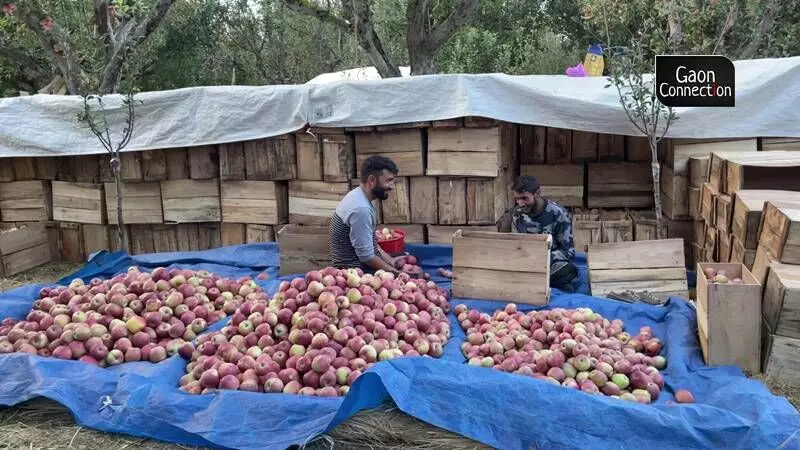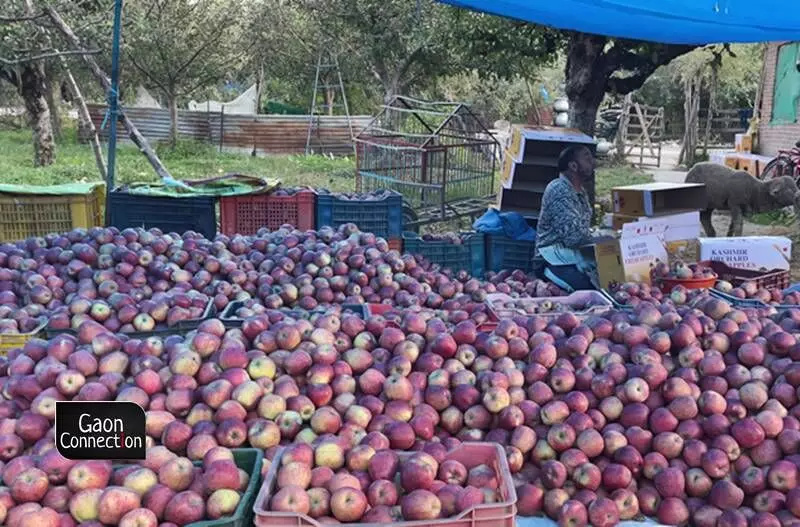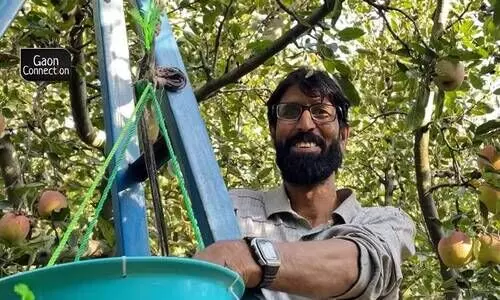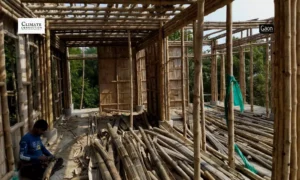Srinagar, J&K
Shariq Khurshid had always cultivated paddy on his eight kanal farm land in south Kashmir. But a decade ago, he switched to apple farming. He gave up growing rice, which is a staple in Kashmiri households.
The 48-year-old farmer said he was happier now. “We switched from paddy cultivation to apple cultivation. The paddy crop used to fetch me Rs 30,000 to Rs 50,000. But, now I earn three to four lakh rupees annually from apples, which is up to ten times more than what I made from paddy,” Khurshid, a resident of Ranbirpora village in district Anantnag of South Kashmir, told Gaon Connection. (20 kanal is equal to one hectare approximately)
Similarly, Ghulam Rasool, a 50-year-old farmer from Marhama village in Anantnag district, used to earn around Rs 20,000 from the paddy he grew on his 10-kanal of land. “But now, we grow apples on the same land which fetches us a profit of three lakh rupees annually. We have a family of six-people and all are dependent on the apple orchard,” he said.
“Several farmers in Kashmir have switched from paddy to horticulture as the latter gives good returns,” he added.
Also Read: Kashmir’s apple crop hit due to low rainfall and drought-like conditions
Rasool’s statement is supported by the data of the horticulture department of Jammu & Kashmir (J&K) accessed by Gaon Connection. As per the department, the area under horticulture cultivation in J&K was 82,486 hectares (ha) in 1975, which went up to 205,543 ha in 1996, and further jumped to 330,956 ha in 2021.
In sharp contrast, land under paddy cultivation has shrunk from 163,000 ha in 1996 to 134,067 hectares in 2021. This is a loss of 28,933 ha under paddy cultivation in the last 25 years. (For reference, one football field measures 0.7 ha approximately)
The reason for the conversion from agriculture to horticulture is because the fruits bring more money to farmers than rice, said Ghulam Rasool Mir, Director Horticulture (Kashmir). “There are many government sponsored schemes under which farmers can avail benefits to grow fruits on their land and increase the production,” Mir told Gaon Connection.
But there is a flip side too. Farmers now have to buy rice from the market to feed their families, something unheard of a few years ago.
“Earlier we grew paddy and had sufficient rice at home. But now with apple cultivation, we purchase rice from the market, which costs us Rs 1,800 a quintal [100 kilogrammes]. And in a year, we need four to five quintals of rice for our personal consumption,” Shariq Khurshid said.

Kashmiri farmers say it is easier to grow apples than paddy.
Also Read: Cold storage facilities could cut immense losses for apple farmers in Chamoli, Uttarakhand
Horticulture is the mainstay of Kashmir’s economy with 700,000 families directly or indirectly associated with the sector. This sector contributes over eight per cent to the Gross Domestic Product (GDP) of J&K.
And apple is the largest horticulture crop grown in J&K. In 1975, the area under apple production was 46,189 ha which jumped to 164,854 ha in 2021, including 147,130 ha in Kashmir and 17,724 ha in Jammu region.
Fifty-year-old Mohamad Abbas Wani and his family have been associated with fruit cultivation for 30 years.
“We grow fruits on 30 kanal of land. Our family of 20 are dependent on the income from the apples. Besides, 20 people are also working with us during the cultivation season. Through apples, we earn a profit of four lakh rupees annually,” Wani, a farmer from Bijbehara in Anantnag district said.

Horticulture sector contributes over eight per cent to the Gross Domestic Product (GDP) of J&K.
Also Read: Vineyards take root in Central Kashmir as apple farmers switch to grape cultivation
According to Shariq Khurshid, horticulture is the backbone of Kashmir’s economy. “The horticulture sector is getting far better returns than paddy cultivation. So farmers should focus more on it as fruits like apples are largely grown in the valley unlike rice which is cultivated in many parts of the country,” the apple farmer said.
Ashfaq Ahmad, a researcher at Sher-e-Kashmir University of Agricultural Sciences and Technology – Kashmir (SKUAST-K), also said it is easier to grow apples than paddy. “Fruits including apples and grapes bring much more money than paddy crops and that is the reason why traditional paddy farmers are switching to horticulture,” Ahmad told Gaon Connection.
Meanwhile, several apple farmers in Kashmir have also switched to growing grapes for additional income.




















